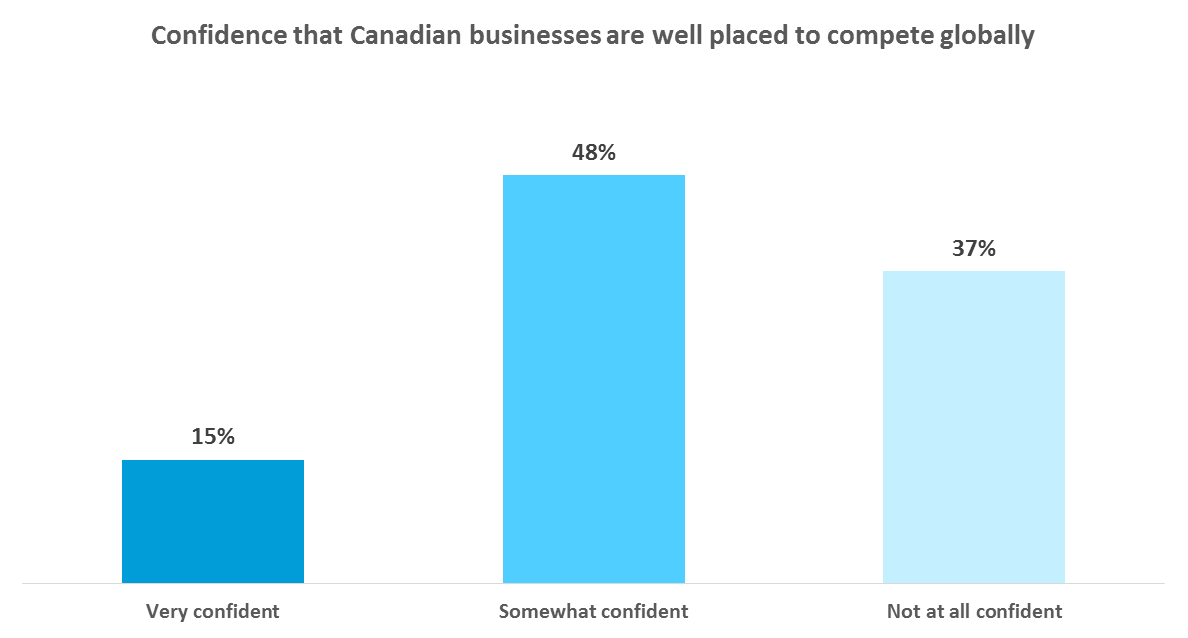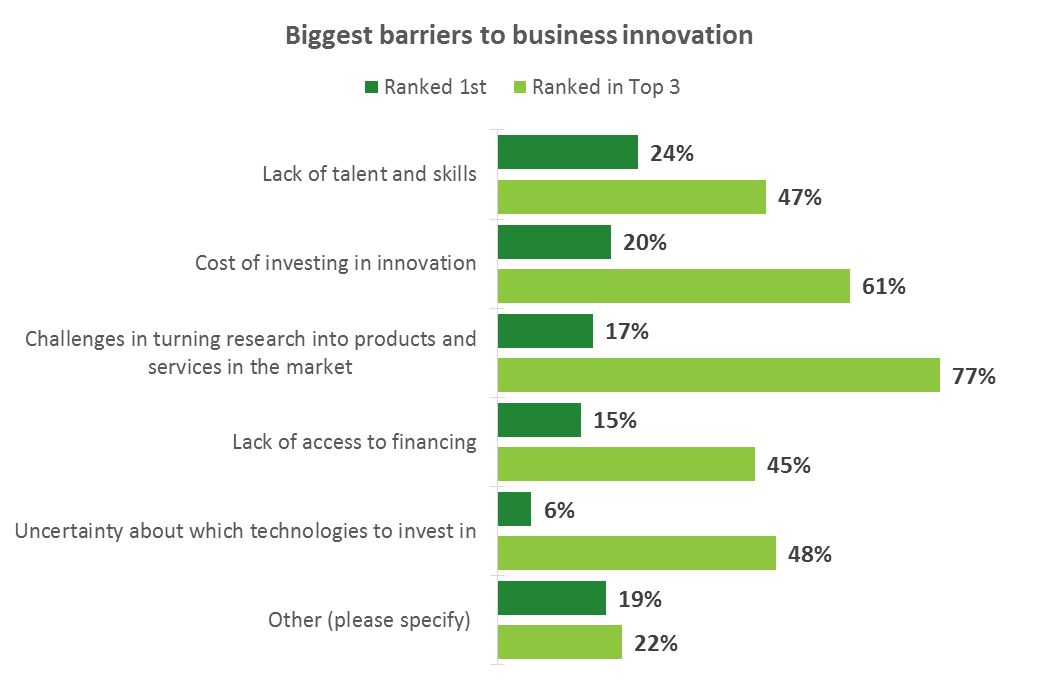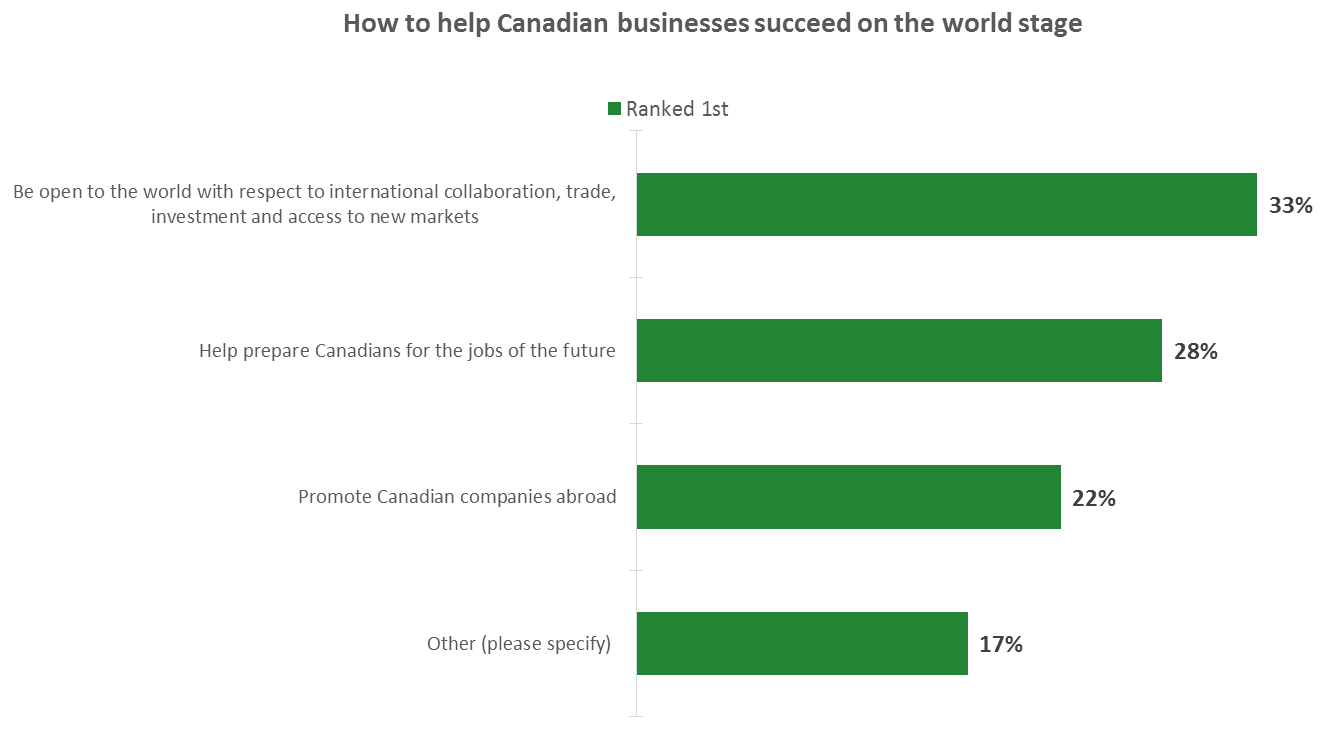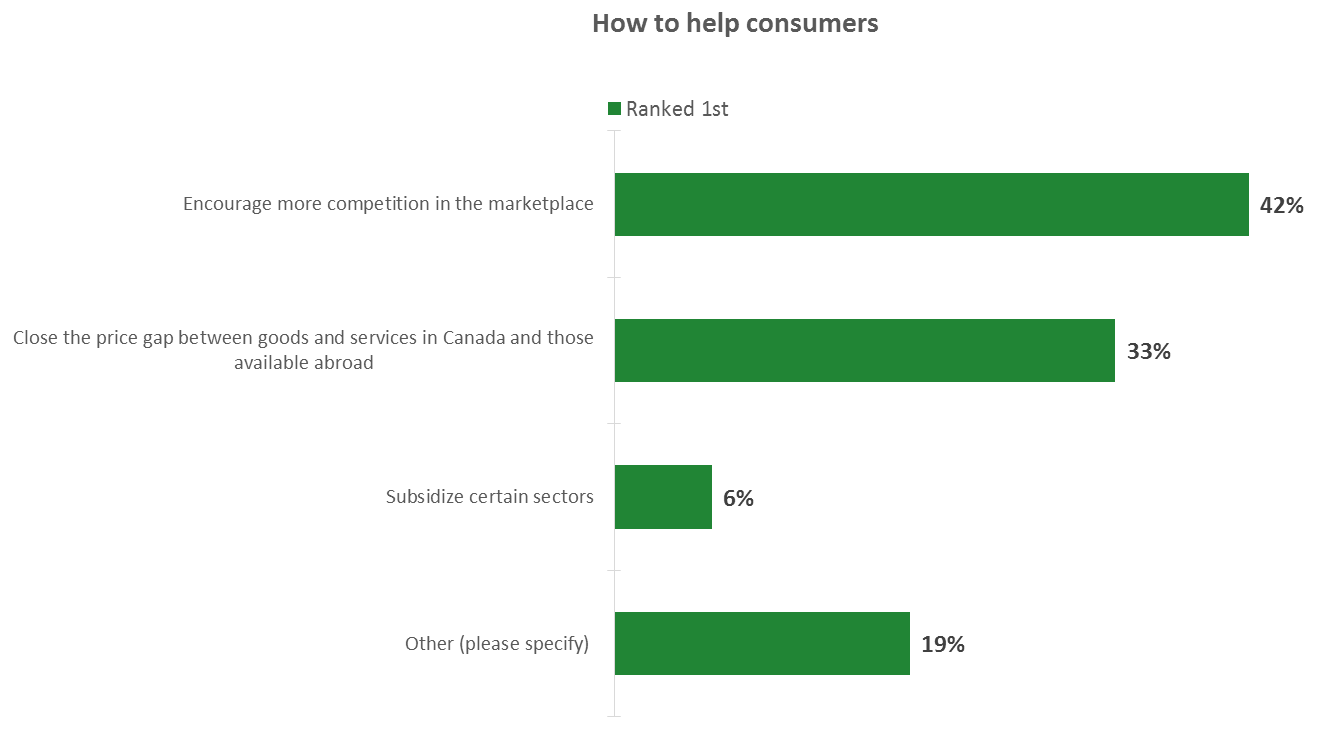Finance Canada 2017 Pre-Budget Consultations Summary Report
Table of Contents
- Background and objectives
- Methodology
- Participation overview
- Investing in transit, housing, the environment and other infrastructure projects
- Improving Canadians' abilities to create new ideas, products and services, and promote them around the world
- Preparing for the jobs of tomorrow
- Creating new opportunities for trade and investment from around the world
Background and objectives
Background
The Government of Canada understands that the right decisions must be made today to ensure Canada is well positioned in the global economy of tomorrow and deliver a brighter and more prosperous future for the middle class, and those working to join it.
To this effect, the Government launched in September 2016 pre-budget consultations to solicit Canadians' views on how best to support a strong and confident middle class. The consultations included in-person interactions, as well as written and online submissions.
This report summarizes the main findings of submissions received online. The online platform was launched September 26, 2016 and closed December 19, 2016.
The Government's pre-budget consultations over the past three months have helped to hone measures for Budget 2017 to ensure they reflect the views of Canadians and their hope for the future.
Objectives
The main objective of the consultations was to engage as many Canadians as possible, as well as Finance Canada’s stakeholders, in an open and transparent way so that their views are considered as an informational input to Canada’s economy and long-term growth.
The objective of this summary report is to highlight key suggestions/issues or recommendations made by Canadians on how to improve the Canadian economy through online submissions.
This information, together with the input received by other means, will allow for the ideas received to be considered as part of the budget development process.
Methodology
Online platform: Finance Canada hosted an online consultation website managed by Publivate to collect the views of the general public through a series of challenges and questions. Canadians were also able to participate in an ideas forum and provide suggestions for improvement.
Alternative methods: Canadians also submitted their views through email and social media.
Data Collection Approach
The online platform allowed Canadians to provide their input through two main data collection methods: 1) eWorkbooks - close-ended questions that allow quantification of results; and 2) ideas forum - an open-ended approach that allowed participants to expand on their ideas and suggestions for improvement.
Four main topics were covered through the methods mentioned above: 1) investing in infrastructure projects; 2) improving Canadians’ abilities to innovate; 3) preparing for the jobs of tomorrow; and 4) creating new opportunities for global trade and investment.
Data Collection Dates
The online consultation platform launched September 26, 2016 and remained open to the general public until December 19, 2016 at 11:59 p.m. PST.
Participation overview
eWorkbooks (online surveys)
Overall, taking into account partially completed surveys across all four topics, a total of 32,826 eWorkbook submissions were received. Details are as follows:
| Topic | Completed eWorkbooks | Partially Completed eWorkbooks | Total |
| Investing in infrastructure projects | 8,376 | 457 | 8,833 |
| Improving Canadians’ ability to innovate | 6,886 | 1,382 | 8,268 |
| Preparing for the jobs of tomorrow | 8,048 | 694 | 8,742 |
| Creating new opportunities for global trade and investment | 6,755 | 228 | 6,983 |
| Total | 30,065 | 2,761 | 32,826 |
Ideas and Improvements
A total of 252 ideas were submitted through the ideas forum. Details by theme are provided below.
| Topic | Ideas Submitted |
| Investing in infrastructure projects | 86 |
| Improving Canadians’ ability to innovate | 55 |
| Preparing for the jobs of tomorrow | 76 |
| Creating new opportunities for global trade and investment | 35 |
| Total | 252 |
Participants were allowed to comment on the ideas and suggest improvements. A total of 591 improvements were submitted.
Social media interactions and email submissions
Below is a summary of social media interactions.
| Reach | |
| Facebook Live Events | 54,011 |
| Google Live Events | 1,415 |
| YouTube – Facebook Live Events | 162 |
| LinkedIn Posts | 4,830 |
| Facebook paid advertising | 869,933 |
| Total | 930,351 |
In addition, a total of 59,783 unique web views were registered.
A total of 656 email submissions were received. Most of the emails included ideas and suggestions within the text of the message and some included attachments.
Summary of findings: Investing in transit, housing, the environment and other infrastructure projects
Longer-term Focus is preferred when it comes to growing and transforming the economy
Overall, 72% of participants would rather have the Government focus beyond the next 12 months when it comes to growing the economy and transforming it so that it works for the middle class.

| per cent | |
| Focus on the day to day | 8% |
| Focus on the next 6 months | 6% |
Focus on the next 12 months |
14% |
| Focus on the next few years | 24% |
| Focus on the long term | 48% |
| Question: In your view, should the Government of Canada focus on the short term or the long term when it comes to growing the economy and transforming it so that it works for the middle class? Base: All respondents (n=8,833) |
|
The importance of Investing to strengthen the middle class is recognized
Just over two-thirds of participants indicate that it is very important for the Government to make investments in the economy that strengthen the middle class; an additional 19% believe it is somewhat important.

| per cent | |
| Very important | 67% |
| Somewhat important | 19% |
| Not important | 14% |
| Question: How important is it for the Government of Canada to make investments in the economy that strengthen the middle class and lead to better opportunities for our children and grandchildren? Base: All respondents (n=8,735) | |
Local Partnerships are perceived as critical by the clear majority
Almost eight of every 10 participants believe it is very important for the federal government to work with provinces, communities, and other local partners to make sure to get the most value for every dollar and that local needs are met. Overall, 91% consider this at least as somewhat important.

| per cent | |
| Very important | 78% |
| Somewhat important | 13% |
| Not important | 9% |
| Question: The Government is investing over $120 billion in public transit, housing, the environment and other infrastructure projects over the next decade. These investments will create jobs now, grow our economy over the long term, and make our communities more liveable. How important is it to you that the federal government work with provinces, communities and other partners to make sure we get the most value for every dollar and that local needs are met? Base: All respondents (n=8,376) |
|
Roads and Bridges are perceived to be the highest priority for infrastructure investment
Just under half of participants select roads and bridges as the highest priority the Government should focus on for infrastructure investment; overall, three-quarters of participants select this within the top three priorities. Other notable priorities are utilities, public transit, and affordable housing.

| Ranked 1st | Ranked in top 3 | |
| Road and bridges | 44% | 76% |
| Affordable housing | 16% | 38% |
| Utilities | 11% | 66% |
| “Green” or environmental infrastructure | 8% | 19% |
| Public transit | 7% | 58% |
| Indigenous communities | 5% | 19% |
| Disaster mitigation | 2% | 13% |
| Other (please specify) | 8% | 11% |
| Question: Keeping in mind that a lot of public infrastructure is owned by provinces and municipalities, which of the following infrastructure areas should be the highest priority for investment by the Government of Canada? Drag to rank, with highest priority at the top. Base: All respondents (n=8,268) |
||
Overview of Ideas and Comments submitted regarding investments in infrastructure
A total of 86 ideas were submitted under the category of investing in transit, housing, the environment and other infrastructure projects. Ideas and improvements suggested were mostly related to transit, the environment, green infrastructure, innovation, and development.
To provide context, some excerpts of the descriptions of ideas are provided below. These ideas were selected for this report given the level of engagement (comments and views) they generated and their relevance to the topic.
Highspeed rail comes to Canada: “The idea is simple - invest in highspeed passenger rail in the most densely populated corridors (Quebec City - Windsor, Calgary - Edmonton, Vancouver - Seattle) of the country and have a long range plan (25 yrs) to expand a higher speed network (sub-TGV speed) to secondary cities (Edmonton - Saskatoon - Winnipeg; Calgary - Regina - Winnipeg; Saskatoon - Regina; Vancouver - Squamish - Whistler; Montreal - St-Hyacenthe Drummond Ville – Sherebrooke etc).”
Increase options for affordable housing/make housing available: “There is a need to have housing available for people who are on income support and disability that is affordable, safe and secure. In most case scenarios, a person on income support will pay over half their income to their rent. That is in a "rooming house" that is available through a private landlord due to the lack of housing that the provincial and federal government operate. This poses a few concerns, there is not always a kitchen and bathroom in the suite and not always even laundry within the house. The utilities are not included. The cost of food makes it impossible for those who are in the poverty or low income demographic to be away from the very core of the city where there is available resources such as the kitchens that feed the homeless and the shelters who will act as food bank dispensaries and the centers that cater to helping the less fortunate access resources and such.”
Summary of findings: Improving Canadians' abilities to create new ideas, products and services, and promote them around the world
There is lukewarm confidence that Canadian businesses are well placed to compete around the world
While the majority indicate that they are at least somewhat confident that Canadian businesses are well placed to compete globally, only 15% indicate they are very confident, compared to more than double (37%) who say they are not at all confident.

| per cent | |
| Very confident | 15% |
| Somewhat confident | 48% |
| Not at all confident | 37% |
| Question: In general, how confident are you that Canadian businesses are well placed to compete around the world? Base: All respondents (n=7,555) |
|
'Turning research into products and services in the market' and 'cost of investing in innovation' are perceived by the majority as top innovation barriers
While lack of talent and skills comes on top as the biggest barrier to overcome when it comes to business innovation, other options take precedence when looking at the top three selections.

| Ranked 1st | Ranked in top 3 | |
| Lack of talent and skills | 24% | 47% |
| Cost of investing in innovation | 20% | 61% |
| Challenges in turning research into products and services in the market | 17% | 77% |
| Lack of access to financing | 15% | 45% |
| Uncertainty about which technologies to invest in | 6% | 48% |
| Others (please specify) | 19% | 22% |
| Question: In your opinion, what are the biggest barriers to business innovation in Canada? Drag to rank, with biggest barrier at the top. Base: All respondents (n=7,273) |
||
Supporting research overall is seen as the most viable way to develop ideas and get them to market
Strengthening support for research and development at higher education institutions is clearly the top option selected by participants to help develop ideas and getting them to market. Promoting partnerships among governments, institutes, and businesses comes in second.

| Ranked 1st | Ranked in top 3 | |
| Strengthen support for research and development at universities and colleges | 43% | 79% |
| Promote partnerships among governments, research institutes and businesses so that knowledge and discoveries generated in the lab make their way to the market | 14% | 72% |
| Improve access to business for financing | 13% | 39% |
| Provide efficient services to businesses with the potential to grow, including advice on potential new markets | 8% | 31% |
| Help companies obtain the talent they need to create ideas and grow their business | 4% | 21% |
| Establish research and development agreements between countries | 3% | 42% |
| Others (please specify) | 14% | 16% |
| Question: What actions would you like to see the Government of Canada take to help Canadians develop their ideas and get them to market? Drag to rank, with most important action at the top. Base: All respondents (n=6,886) |
||
Overview of Ideas and Comments submitted regarding Innovation
A total of 55 ideas were submitted under the category of improving Canadians’ abilities to create new ideas, products and services, and promote them around the world. Ideas and improvements suggested were mostly related to innovation, business, jobs, growth, and children’s education.
To provide context, some excerpts of the descriptions of ideas are provided below. These ideas were selected for this report given the level of engagement (comments and views) they generated and their relevance to the topic.
Improve small and medium-sized enterprise innovation by differentiating science policy from innovation policy: “Over several decades, Canada has concentrated primarily on the input of ideas as the spark for innovation, instead of fostering an innovation economy that responds to demand for ideas, demand for solutions, and consumer or market demand for new products or services. While significant funding for science excellence has generated globally recognized results in their own right, it has not translated into innovation outcomes that increase national productivity. In the continuum between science and innovation, the time is now to focus government action and funding on initiatives that propel innovation, such as applied research and commercialization of research.
Canada’s innovation performance is not optimal due to the lack of policies and programs that strongly support applied research and industry demand for innovation.”
Creativity, education, and small businesses: “For many graduating students jobs in their field are few. For the small business owners finding the right candidate with specific skills can be challenging but more importantly the cost of running a business is often met with financial pressures with basic needs for the business to operate such as liability insurance costs, professional liability fees, utility costs to operate, staying up to date with technology to provide the environment for employees and companies to stay afloat or flourish if possible. It is important for the small business to hire the right candidate, creative by sharing ideas in productivity, product, service, cost effectiveness, and local.”
Summary of findings: Preparing for the jobs of tomorrow
The lack of job opportunities is perceived as the top barrier to getting a job
Given the limited options, top 3 ranking has been omitted.

| Ranked 1st | |
| Too few job opportunities | 45% |
| Difficulty balancing personal and work obligations | 30% |
| Inadequate opportunities for learning | 8% |
| Others (please specify) | 17% |
| Question: In your community, what barriers do you see to people getting a job? Drag to rank, with biggest barrier at the top. Base: All respondents (n=8,742) |
|
Investments in developing targeted skills are preferred for federal investments
Support for apprenticeship opportunities, co-op placements, and internships is by far perceived as the top federal investment the Government should focus on to help Canadians get a good job.

| Ranked 1st | Ranked in top 3 | |
| Support for apprenticeship opportunities, co-op placements and internships | 47% | 91% |
| Supporrt for education and training that reflect the needs of the labour market of tomorrow | 15% | 90% |
| Investment of communities through things like transit, housing, the environment and other infrastructure projects | 13% | 33% |
| Investment in post-secondary education | 12% | 70% |
| Others (please specify) | 14% | 16% |
| Question: Which areas require more federal investment to help Canadians get a good job? Drag to rank, with highest priority at the top. Base: All respondents (n=8,209) |
||
Opinion is split between creating a fund for skills-focused learning and investing in people and the economy as more effective actions for getting a job
Given the limited options, top 3 ranking has been omitted.

| Ranked 1st | |
| Creating a fund for skill-focused learning | 40% |
| Investing in people and the economy | 38% |
| Making it easier to attract talent to Canada from abroad | 3% |
| Others (please specify) | 19% |
| Question: Which of the following actions do you think will have the greatest chance of helping Canadians get a good job? Drag to rank, with highest priority at the top. Base: All respondents (n=8,048) |
|
Overview of Ideas and Comments submitted regarding Preparing for the Jobs of Tomorrow
A total of 76 ideas were submitted under the category of preparing for the jobs of tomorrow. Ideas and improvements suggested were mostly related to jobs and workforce in general, education, business, development, and growth.
To provide context, some excerpts of the descriptions of ideas are provided below. These ideas were selected for this report given the level of engagement (comments and views) they generated and their relevance to the topic.
Develop our natural resources: “We need a government to help companies develop the natural resources this country has to offer and reduce our dependency on imports. This includes Oil and Gas, Lumber, hydro electric power, farming and ranching, minerals and metals. These core industries will spin off other industries and benefits to all Canadians. This will put people to work and make Canada a world wide leader in how to run a country like a profitable and sustaining business.”
An inclusive national skills strategy: “Presently, Canadians obtain record levels of post-secondary education. Yet this does not convert into strong employment outcomes – the national unemployment rate sits at 7%, while the youth unemployment is nearly twice this. It is not for a lack of talent that we are experiencing jobs without people and people without (quality) jobs. Instead, it’s because of how we are developing this talent, and the skills we are equipping individuals with.
In Canada, we do not have high quality, timely, comparable, and granular labour market data, with which we can signal to students, employees, and other learners, parents and guidance counsellors, the fields of study or credentials they should pursue. The result: too many students with general education that comes at high financial cost, and people working jobs that are not well matched to (and often well below) the skill sets acquired through study.”
Summary of findings: Creating new opportunities for trade and investment from around the world
Participants have mixed views on how to help Canadian businesses succeed on the world stage
There is no clear preference between being open to the world with respect to international collaboration, helping Canadians prepare for the jobs of the future, and promoting Canadian companies abroad.
Given the limited options, top 3 ranking has been omitted.

| Ranked 1st | |
| Be open to the world with respect to international collaboration, trade, investment and access to new markets | 33% |
| Help prepare Canadians for the jobs of the future | 28% |
| Promote Canadian companies abroad | 22% |
| Other (please specify) | 17% |
| Question: How can the Government of Canada help Canadian businesses succeed on the world stage? Drag to rank, with highest priority at the top. Base: All respondents (n=6,983) |
|
Encouraging more competition in the marketplace is perceived as the best way the government can help consumers
Closing the price gap between goods and services in Canada and those abroad is also preferred by a notable proportion of participants. Subsidizing certain sectors is clearly the least popular option.
Given the limited options, top 3 ranking has been omitted.

| Ranked 1st | |
| Encourage more competition in the marketplace | 42% |
| Close the price gap between goods and services in Canada and those available abroad | 33% |
| Subsidize certain sectors | 6% |
| Others (please specify) | 19% |
| Question: How can the Government of Canada help consumers? Drag to rank, with highest priority at the top. Base: All respondents (n=6,855) |
|
For almost half of participants, maintaining a healthy Canadian economy is the key for attracting more investments to Canada
Given the limited options, top 3 ranking has been omitted.

| Premier rang | |
| Maintain a healthy Canadian economy | 48% |
| Create and maintain international agreements | 24% |
| Promote Canada abroad | 11% |
| Others (please specify) | 17% |
| Question: How can the Government of Canada attract more investment to Canada? Drag to rank, with highest priority at the top. Base: All respondents (n=6,816) |
|
Investing in Clean technology and offering incentives to people and businesses that adopt clean technology are perceived as the best ways to create 'clean growth'
Putting a price on carbon is clearly the least popular option.
Given the limited options, top 3 ranking has been omitted.

| Ranked 1st | |
| Invest in clean technology that both grow the economy and protects the environment | 46% |
| Offer incentives to people and businesses that adopt clean technologies | 25% |
| Put a price on carbon | 6% |
| Others (please specify) | 23% |
| Question: How can the Government of Canada best create “clean growth” - growth that balances the economy and the environment? Drag to rank, with highest priority at the top. Base: All respondents (n=6,755) |
|
Overview of Ideas and Comments submitted regarding creating new opportunities for Trade
A total of 35 ideas were submitted under the category of creating new opportunities for trade and investment from around the world. Ideas and improvements suggested were mostly related to business and trade.
To provide context, some excerpts of the descriptions of ideas are provided below. These ideas were selected for this report given the level of engagement (comments and views) they generated and their relevance to the topic.
Not with deficit spending: “Turn the private sector lose and let them do their job of creating wealth and jobs will follow. Government can not create jobs only destroy them or make them burdened under tons of unneeded red tape, ask any person that has run a small business and you will find out for yourself.”
International education – a platform for trade and investment: “The next generation of Canada’s entrepreneurs, researchers and innovators require a broad set of skills to succeed in and contribute to the global marketplace of ideas. This means giving all university students access to global study and work-integrated learning opportunities.
Learning across borders is part of a 21st century education. Only 3.1 percent of full-time Canadian undergraduate students (approximately 25,000) go abroad in any given year, despite 97 percent of universities offering international experiences. Cross-sectoral collaboration is required to ensure young Canadians take part in opportunities that will allow them gain the international and intercultural competencies that will be of value to their employers as they launch their careers.”
